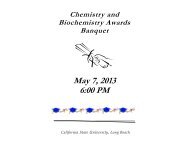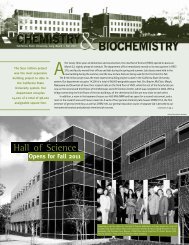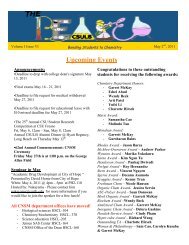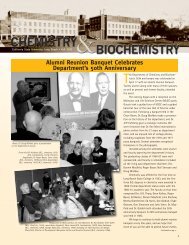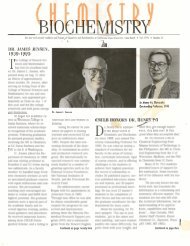2001 - California State University, Long Beach Department of ...
2001 - California State University, Long Beach Department of ...
2001 - California State University, Long Beach Department of ...
- No tags were found...
You also want an ePaper? Increase the reach of your titles
YUMPU automatically turns print PDFs into web optimized ePapers that Google loves.
ChemistryBiochemistrySome <strong>of</strong> the faculty and students in attendance at the 29th Annual Awards Banquet in May. Seated left to right:Dmitry Pervitsky, Dr. Ximeng Wang, Dr. Paul Buonora and Dr. Peter Baine.Dennis AnjoMy research continues with bothcarbon electrode studies and somenew work on organoborane compounds.Paul Sierocki has workedon the pH response <strong>of</strong> carbon electrodes,extending our diagram <strong>of</strong>the pH, potential and response surfacefor carbon electrodes. Paul hasalso developed buffers that workin electrochemistry experiments,without causing interference. Hewas accepted in the PhD programat UCLA for the fall <strong>2001</strong>.Jared Ashcr<strong>of</strong>t has also beenworking in my group. Jared isstudying the emission spectrum <strong>of</strong>tri-anthracene borane. His workhas indicated that the emission <strong>of</strong>the compound is not the traditionalKasha type. Multiple emissionpeaks are observed in condensedmedia. Jared is also going on tograduate school, beginning thePhD program at Rice this fall <strong>2001</strong>.I met a former student <strong>of</strong> mine,Greg Whitaker (BS Biochemistry1990), during the last week <strong>of</strong>classes. Greg is at present workingin anesthesiology, and will be finishinghis residency soon. Gregalso brought greetings fromMichael Wanger (BS Biochemistry1990), who is now practicing medicinein Florida.Paul BuonoraAs I write these comments it isexactly one year since my wife,Sarah, and I arrived in <strong>Long</strong> <strong>Beach</strong>to look for housing and begin ourlives in <strong>California</strong>. The year hasbeen full and gone by quickly. Thefaculty, students and universityhave lived up to all the hopes Ihad when I accepted the position.Nail Senozan organized a welcomeparty, and Ken Marsi wasvery helpful in assisting Sarah infinding a position in dental materialsresearch working with <strong>Long</strong><strong>Beach</strong> alum Greg Dorsman (BSChemistry 1977, MS Chemistry1983) at Danville Materials. Myorganic colleagues have given adviceand guidance as I learn tonavigate life at CSULB and inSouthern <strong>California</strong>.On the research front, threeundergraduate students will beginwork this summer and a half dozenothers have expressed interestin starting research in the fall. Wehope to make short work <strong>of</strong> tyingup loose ends on chiral gamma-dicarbonylsynthesis projects whichwere nearly complete when I leftPennsylvania.The corrected galley pro<strong>of</strong> <strong>of</strong> aninvited review with Tae Oh <strong>of</strong> CSU,Northridge, <strong>of</strong> recent progress inimino Diels-Alder reactions, wasreturned to the journal Tetrahedronin late May.I have not had much time forwork in the history <strong>of</strong> chemicalscience, but I was asked to sit onthe Outstanding Paper SelectionCommittee <strong>of</strong> the Division for theHistory <strong>of</strong> Chemistry <strong>of</strong> the ACS.Next year I will chair that committee.In the teaching arena, I taughtthe Organic Chemistry 320 sequencethis year. In the second semestermy class participated inbeta testing the questions for the2002 version <strong>of</strong> the ACS organicexamination. In the laboratory forthat course we replaced mercurythermometers with digital thermometers,an innovation I had utilizedin Pennsylvania. This investmentshould provide dividends inthe future as we eliminate mercuryspill cleanup and reduce replacementcosts. Currently, I amorganizing materials to teach aSpecial Topics: Medicinal Chemistrycourse in the spring <strong>of</strong> 2002.Jeffrey CohlbergSummer and fall <strong>of</strong> 2000 werespent on a sabbatical leave in TonyFink’s lab at UC Santa Cruz. Iworked on the protein α-synuclein,which aggregates to form Lewybodies in the brain cells <strong>of</strong> Parkinsonpatients. The aggregation canbe replicated in the test tube. Idiscovered that this process isstimulated by glycosaminoglycansand obtained some informationabout the mechanism <strong>of</strong> this stimulation.The work generated datafor two manuscripts, one <strong>of</strong> whichwas submitted for publication thisspring. Santa Cruz was a delightfulplace to spend seven and 1/2months, and in particular the<strong>Department</strong> <strong>of</strong> Chemistry and Biochemistrythere provided a stimulatingand friendly environment.While in Santa Cruz I guidedGene Rozumov and Frank Le tocomplete their MS theses. Theyare both now at UCLA, Gene inthe PhD program in organicchemistry and Frank in dentalschool. Paula Spencer is finishingher thesis while she works as aprotein chemist at Amgen. I taughtChem 441B in the spring andhave been working in the lab withthe aim <strong>of</strong> finishing my currentproject on neur<strong>of</strong>ilament proteininteractions. I am also working ona curriculum development involvingthe use <strong>of</strong> molecular modelingby students in biochemistry courses.Dorothy GoldishIn addition to teaching classes andserving as the undergraduate advisingcoordinator for the department,I have been serving on twoimportant university committees.In the past year, we have beenpreparing our self-study for reaffirmation<strong>of</strong> accreditation by our regionalaccrediting body, the WesternAssociation <strong>of</strong> Schools andColleges. With Vice President forStudent Services Douglas Robinson,I co-chaired the task forcewriting a section on Services toStudents. (Dr. Merryfield was cochair<strong>of</strong> the task force writingabout General Education.)We were writing about somethings that have been going well,but mostly about efforts to correctsome <strong>of</strong> the problems alumni nodoubt remember, such as slowgrad checks, late evaluation <strong>of</strong>transfer credit, difficulty gettinginformation about financial aid,non-functional classrooms andothers. The good news is thatmany <strong>of</strong> these have been greatlyimproved. Grad checks are donequickly, admissions and financialaid information go out more efficiently,advisors have access totransfer records and other usefulinformation so we can give accurateanswers, some classroomshave been air-conditioned andequipped for modern technology(but others are still waiting forrenovation.)I am also a member <strong>of</strong> the committeedealing with enrollmentmanagement. The university’s enrollmenthas been increasing rapidly,especially with an increasingnumber <strong>of</strong> freshmen. We are rapidlyrunning out <strong>of</strong> classroomspace and many departments arefinding it impossible to hireenough faculty members to teachall the classes needed. We havenow received approval from theChancellor's Office to limit thesize <strong>of</strong> the freshman class, startingwith the class entering in fall2002. This doesn't mean that wewill turn away highly qualified studentsor that we will redirect studentswho live and work close toCSULB to other campuses.Under our plan, we will continueto admit all students fromschool districts close to the campuswho meet the minimum CSUentrance requirements, but willimpose somewhat higher standardsfor students from school districtsfarther away. This will be based onthe CSU “eligibility index” whichcombines high school grade pointaverage with scores on the SAT orACT exam. A study <strong>of</strong> predictors<strong>of</strong> student success showed thatthis index gave us better predictionsthan using grades or testscores alone. Students who are initiallydenied admission wouldhave the opportunity <strong>of</strong> attendinganother CSU campus or <strong>of</strong> attendinga community college and thentransferring. We will continue toadmit all eligible upper divisiontransfer students.(Editor’s Note: After submittingthe above narrative, Dr. Goldishwas appointed acting dean <strong>of</strong> UndergraduateStudies and will notbe teaching during the <strong>2001</strong>-2002academic year.)Lijuan LiDr. Lijuan Li, assistant p<strong>of</strong>essor <strong>of</strong>inorganic chemistry, was promotedto associate pr<strong>of</strong>essor effective thebeginning <strong>of</strong> the <strong>2001</strong>-2002 academicyear.In March <strong>2001</strong>, Dr. Li wasawarded a SCORE (Support forContinuous Research Excellence)grant by the NIH in the amount<strong>of</strong> approximately $500,000 for aperiod <strong>of</strong> three years. She has alsobeen notified that she is the recipient<strong>of</strong> two additional grants: (1)an American Chemical SocietyPertroleum Research Fund grant($25,000) and (2) a ResearchCorp. grant ($34,238).Dr. Li joined our department in1998 and in the past three yearsshe has published eight papers injournals such as the Journal <strong>of</strong> theAmerican Chemical Society, Journal<strong>of</strong> Polymer Science and theCanadian Journal <strong>of</strong> Chemistry.The article, “Metalloporphyrin-4



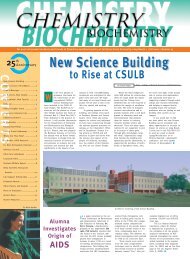
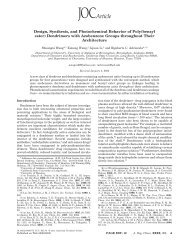
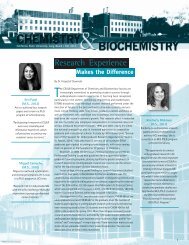
![Volume 4, Issue 3 [November 2012 pdf] - California State University ...](https://img.yumpu.com/34605825/1/190x245/volume-4-issue-3-november-2012-pdf-california-state-university-.jpg?quality=85)
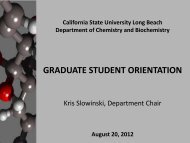
![Volume 5, Issue 2 [April 2013 pdf] - California State University, Long ...](https://img.yumpu.com/33273195/1/190x245/volume-5-issue-2-april-2013-pdf-california-state-university-long-.jpg?quality=85)
